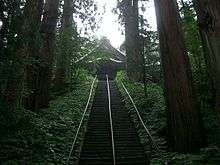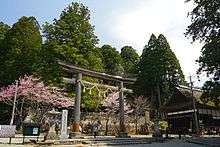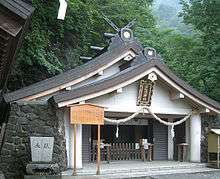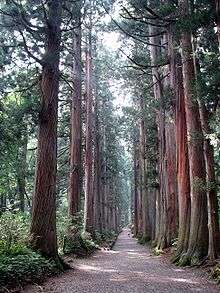Togakushi Shrine
The Togakushi Shrine (戸隠神社, Togakushi Jinja) is a Shinto shrine in Togakushi, Nagano (city), Nagano Prefecture, Japan. The shrine is at the base of Mount Togakushi (1,904 metres (6,247 ft)) in Myōkō-Togakushi Renzan National Park.[1] Togakushi Shrine consists of five shrines, known as the lower, middle, and upper shrine area (Togakushi Hōkō-sha, Hino-miko-sha, Togakushi Chū-sha, Togakushi Oku-sha and Kuzuryu-sha respectively), each area about 2 km apart.
| Togakushi Shrine (戸隠神社, Togakushi Jinja) | |
|---|---|
 The lower shrine Hōkō-sha | |
| Religion | |
| Affiliation | Shinto |
| Location | |
 Shown within Japan | |
| Geographic coordinates | 36°44′34″N 138°05′07″E |



The approach to the upper shrine is lined with over 300 Cryptomeria trees, some believed up to 900 years old.[2]
Kuzuryu means nine-headed dragon. The dragon is calling for rain, and Togakushi village has abundant spring water from mountains.
- The Hōkō-sha (lower shrine) is to a patron goddess, protecting maternity, academic life, and sewing
- The Hino-miko-sha is God of fire and the performing arts
- The Chū-sha (middle shrine) is God of wisdom
- The Oku-sha (upper shrine) is God's marvelous threw rocks
- The Kuzuryu-sha is God of rain and landowner God of Togakushi villages
Around five shrine and pilgrimage certification seal gosyuin to make things possible.[3]
History
In one theory, the upper shrine, or Oku-sha, is said to have been first constructed in the 5th year of the Emperor Kogen (210 BC) while Buddhist tradition holds that a monk named Gakumon discovered the Oku-sha area and began the practice of Shugendo there in the 2nd year of the Kasha era (849 AD). According to the Nihon-Shoki, the Emperor Tenmu had a map of the area made in 684 AD and a temporary building built the following year.
Togakushi shrine was a pilgrimage site during the following eight centuries. Its name was ranked with the Ise-jingu Shrine, Koya-san Temple and Enryaku-ji temples. Togakushisan Kansyuin Kenkou-ji was the formal name of the Togakushi Temple.
Two major esoteric Buddhist sects, Shingon and Tendai fought for the hegemony of Togakushi Temple. Eventually the Shingon sect lost the battle. Togakushi Temple was changed to a shrine by the Meiji government's Buddhism/Shinto separation initiatives "Shinbutsu bunri", "Haibutsu kishaku", and the 1868 Temple Ordinance. Until that time, it was common in Japan for the same buildings to be used as both temples (Buddhist) and shrines (Shinto). Until the 19th century, Buddhist activities at the Togakushi Temple were dedicated to "Avalokiteśvara".
Site
Upon arrival at Togakushi it is recommended to first visit Oku-sha and then Kuzuryu-sha. It is a 2 kilometer hike from the entrance to the two shrines, however the path leading deep into the mountain can only be taken on foot. Beyond the cedar-lined path, you will be able to see the torii gate for Oku-sha at the bottom of the mountain and the shaden main building of the shrine as well. During winter the paths are closed but snowshoeing may be possible.[4]
See also
- List of Shinto shrines in Japan
- Modern system of ranked Shinto Shrines
References
- "Togakushiyama". Dijitaru Daijisen (in Japanese). Tokyo: Shogakukan. 2012. OCLC 56431036. Archived from the original on 2007-08-25. Retrieved 2012-12-04.
- https://naganonow.com/explore/togakushi-village-shrine/
- https://www.google.co.jp/search?q=%E5%BE%A1%E6%9C%B1%E5%8D%B0&oe=utf-8&aq=t&rls=org.mozilla:ja:official&hl=ja&client=firefox&um=1&ie=UTF-8&tbm=isch&source=og&sa=N&tab=wi&biw=1154&bih=568&sei=G6JZULLzOOqZmQXVyYDADQ
- https://naganonow.com/explore/togakushi-village-shrine/
External links
![]()